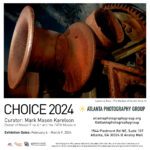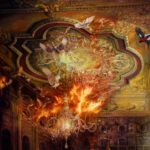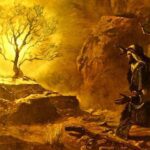LAWRENCE RUSS: Soul, Art, and Society
Archives: Creative Power
One of the Most Important Things to Be Said – but Which Almost No One Says – about Our Photography

If what we really want from our photography is popularity, or praise from supposedly-important members of the “industry,” or a lot of money, or if we don’t think of ourselves as making art, then we won’t care about this. But our not-caring won’t change the crucial truth: If our goals are shallow, our photographs will be shallow. If we mainly want to make our photographs bright and brilliantly-colored, in order to catch people’s momentary attention on a screen, then that’s what they’ll be. If our principal aim in life is superficial, centered on worldly success or values, then our photographs will be superficial, no matter whether or not they’re shown in a prestigious gallery or praised by the writers for prominent publications.
No, No, “Arcane” Doesn’t Mean Anything Like “Archaic”!

I’ve already written and published on this blog, on October 19, 2014, a post about the portfolio that includes this image — shortly after I self-published a book of the photos in that series: . . . What is kinda funny to me is that after naming that book with what was then the name of the series, “The Arcane Machine,” I felt forced to change the portfolio’s name, because I could tell from people’s responses that many of them mistakenly thought that “arcane” meant something like “archaic.”
Visionary “Correspondences”

. . . That is what opens up, in immersive fashion, in mystical experience: a sense that one is experiencing not some kind of glorious hyper-illusion, but rather the universe as it really is, when the doors of our perception are opened. And it’s that manner of vision that the greatest artists to try to evoke or manifest by their art, in works such as “Pepper No. 30” or Wynn Bullock’s “galactic” “Tidepool, Point Lobos” or Olivier Messiaen’s Lightning over the Beyond or Shakespeare’s The Tempest. And it’s central to what I pursue in my own art, in photos like “The Window Is at Your Feet,” “Ritual,” “Grass of the Midnight Sea,” “The Tree of Unsleeping Surveillance,” “Uprooted,” the “Marion” images, most of the works throughout my portfolios.
A Surprise Communion across Continents, Classes, Centuries, and Cultures

. . .In dejection from all the awful and discouraging news about reactionary political victories, rampant viral sub-variants, catastrophic droughts, and increasing violence (as well as, for me, unhappy views about my own self), I found myself doing something that I’ve done on occasion over the years, especially under stress: I was hand-writing, long past midnight, a list of my favorite artists and mystical writers. That exercise can calm and comfort me. not just as an obsessive-compulsive ritual, but as a reminder of real treasures that I’ve been given, for inspiration and illumination.
The Self behind the Self – Juan Ramon Jimenez and Jim Carrey (yes, That Jim Carrey)

In certain of these posts, I’ve put together two stories or quotes that go at one thing from different directions, or whose common ground isn’t obvious on the surface, aiming to spark for you some realization that can’t just be given or explained. This time, the two sets of words that I’ve joined come from two seemingly-almost-comically-different sources. The first is a poem by Juan Ramon Jimenez, the Spanish poet who won the 1956 Nobel Prize for Literature and was a leading figure in what is sometimes called (with good reasons, like the writing of his kinsmen Antonio Machado and Lorca). The second set of words is from a speech by the American comic actor Jim Carrey. Jimenez may not have had the same kind of extremely zany humor that Carrey has shown in his movie and TV career, but Jimenez was anything but a stiff. One of his most wonderful books is a work of prose, Platero y Yo (Platero and I). Platero was his donkey.
Towers and Devices of an Alien Race

I want to introduce you to a new portfolio of mine: “Towers and Devices of an Alien Race.” But I don’t, don’t want to squeeze it into an ill-fitting box of conceptions or drown it in chat about techniques or influence. Still, I want to tell you a few of the thoughts and feelings that I had in making these works.
The Music of the Spheres

Recently, my wife and I watched a 1980 documentary about the avant-garde composer and musician, and idiosyncratic, self-styled visionary, Sun Ra — Sun Ra: A Joyful Noise, directed by Robert Mugges. The life of outer space and the mythology of Ancient Egypt were touchstones for Ra, acknowledged sources for his music, self-image, clothing and stage settings.
“The Friend Who May Not Seem a Friend” – The Cat and the Fire, Post 3 of 3

Fire has often been not just a symbol of the holy Spirit, but its embodiment. . . Even fewer people will know what faith and fire lay behind the phrase “Chariot of fire.” It refers to certain events concerning the prophet Elisha, told in 2 Kings 6:8-17.
“The Friend Who May Not Seem a Friend” – The Cat and the Fire, Post 2 of 3

I wrote to you about the story of the cat at the heart of this photograph, but why is the cat wreathed in flames, and why don’t they consume him? I’ll respond to that now, not with pretended analysis or explanation, but with a kind of “Biography of Fire.” . . .
“We interrupt our regularly-scheduled programming to bring you this important message. . . .”

As I said I would, I’ll write to you soon about the Fire in “The Friend Who May Not Seem a Friend.” But I have to share with you first an exceptional, timely gift that came to me this week.